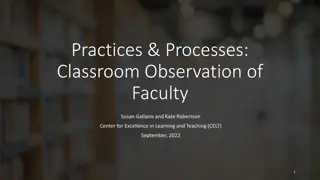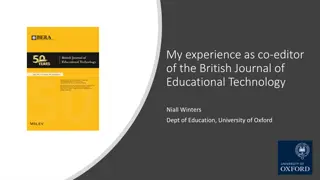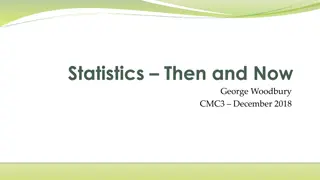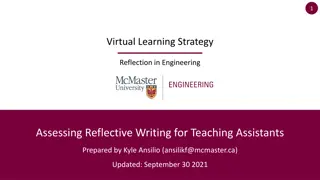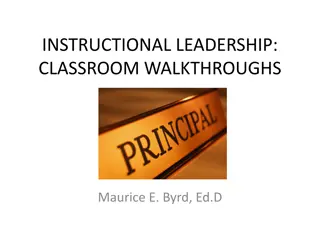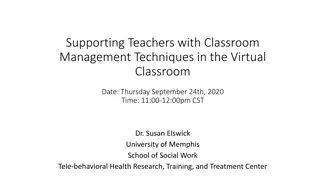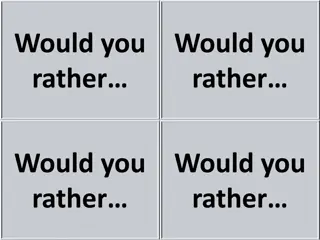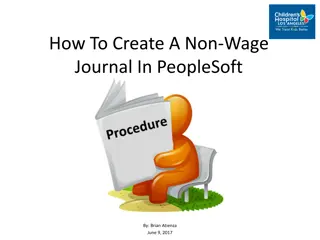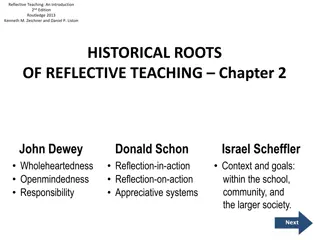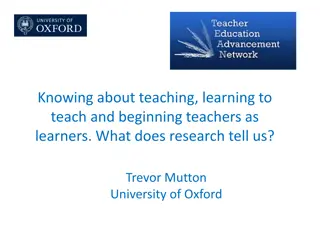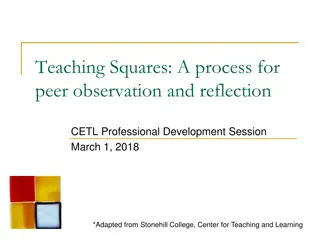Enhancing Classroom Teaching: Journal Presentation Reflection
Reflecting on a recent journal presentation, this piece explores learning outcomes, new insights gained, practical applications in teaching, areas of uncertainty, challenges faced, and alignment with educational books in Education for Teaching (EfT).
Download Presentation

Please find below an Image/Link to download the presentation.
The content on the website is provided AS IS for your information and personal use only. It may not be sold, licensed, or shared on other websites without obtaining consent from the author. Download presentation by click this link. If you encounter any issues during the download, it is possible that the publisher has removed the file from their server.
E N D
Presentation Transcript
Journal Presentation 1.What have you learnt? 2.What was new to you? 3.How could you apply those in the classroom teaching? 4.What was not clear to you? 5.Which one did you find difficult? 6.Which one is not relevant to the contents of EfT books? 7.Write your comments on that day s sessions?
Welcome To 3rd Day s Training Session s
Day-3 Session-1 Listening and Speaking Skills Activity-1: Warm-up: (Replaced using EIA video clips D3_S1_ A1)
Activity-2: IdentifyingImportance of listening and speaking skills. (Revised using EIA audio clips D3_S1_A2a, D3_S1_A2b, D3_S1_A2c, and D3_S1_A2d) Dear participants, You are going to listen to a story. Please read the questions . While you will listening to the audio You have to find out the answer. *** On which day did the Caterpillar eat a banana and an apple? ***When did the Caterpillar feel stomach ache? ***What did the Caterpillar do on Friday?
Tell participants to discuss why listening and speaking is important at primary level. Participants discuss this in pairs and make notes. Give them 5 minutes for this activity. Hand out the Resource Paper-13, the importance of speaking and listening. Tell them to read it for 5 minutes (or longer if required). Walk around the room and monitor.
Resource Paper-13 Importance of Listening It is easier for young children to listen to English than to read and write it. Children will often understand much more than they can say or write. If students listen to a lot of English, they will be able to pick up more words and phrases. Some children learn better when they hear information, rather than seeing it. Listening to a foreign language is difficult. If children listen to a lot of English, then they will get better at listening to English. It helps students with pronunciation and speaking. If students hear words, then they know how to pronounce them. Children need to hear English before they can speak it. Children in Bangladesh often don t get many opportunities to listen to English outside the classroom. For some children, the classroom may be the only place where they can listen to English. Listening is one of the four skills of the English Primary Curriculum in Bangladesh. One of the main objectives of Classes 1-5 is for students to understand simple commands/instructions/requests in English and carry them out; and for students to understand simple English, such as simple questions and statements
Importance of speaking It is motivating for children to learn to say words and phrases in English. When they can say new words and phrases, they feel that they are making progress. When you are learning something, you need to do it. So children need to practise speaking English if they are going to learn to speak it. If students have lots of opportunities to speak English in the classroom, they will develop confidence in speaking English. Young children are often very good at imitating and playing with spoken language. By practising oral skills such as listening and speaking, teachers are working with the strengths of their students. Speaking is essential to help students to learn English properly. Improving their speaking will also improve their reading and writing, and so help them in the exams. The speaking parts of the lessons are often the most enjoyable parts. They can make students feel that English is an interesting subject that they want to learn. Speaking English may be very useful in students future lives. Children in Bangladesh often don t get many opportunities to speak English outside the classroom. For some children, the classroom may be the only place where they can speak English. Speaking is one of the four skills of the English Primary Curriculum in Bangladesh. One of the main objectives of Classes 1-5 is for students to use spoken English in a number of situations
Activity-3: Identifying the listening & speaking activities in the EfT books. Resource Paper-14 Possible Activity Look, Listen, say/do Reading aloud Memory games Dialogue practice Answering questions (for example around pictures, reading or listening texts) Open questions and answers (for example students asking each other about families) Role play (for example, acting out dialogues and plays) Rhymes, and songs Stories Guessing games Describing pictures Talking about a picture Exchanging personal information Social talk in the classroom (for example, about holidays or festivals) Taking interviews Debate Audio recordings Teacher/students talk
Dividing in to group of 5 You will have to find out activities of listening and speaking in their textbooks and make a list of those using the following table. Group No. Name Class 1 Rose 1 (Unit:5. P: 10) 2 Marigold 2 (Unit: 10:P:20) 3 Sunflower 3 (Unit: 13.P:26) 4 Night Queen 4 (Unit: 5.P:11) 5 Chrysanthemum 5 (Unit: 3.P:10)
Class Unit, Lesson Listening activities Speaking activities Listening & speaking activities
Stages of listening and speaking For recognizing words: Pre-listening/speaking Help students to guess the meaning of unknown words using context. While-Listening/speaking Present the words/numbers orally as the child listens. Then ask the children to reproduce the words/numbers orally as the child speaks. Do some activities like: listen and show/ matching. Post-listening/speaking Provide feedback on the strengths and area of improvement. Use activities like: look and say/point and say For text presentation: Pre-listening/speaking Discussing the topic or type of conversation with the learners. Helping the learners to develop their vocabulary related to the topic. While-Listening/speaking Ask learners to read and understand the questions/fill in the blanks/True-False. Tell them to listen to the text and answer the question (teacher will read the text aloud). Let students listen to the text again and do the task while listening (if necessary). Post-listening/speaking Give feedback, and consolidate what they have learnt.
Resource Paper-14 Possible Activity Look, Listen, say/do Reading aloud Memory games Dialogue practice Answering questions (for example around pictures, reading or listening texts) Open questions and answers (for example students asking each other about families) Role play (for example, acting out dialogues and plays) Rhymes, and songs Stories Guessing games Describing pictures Talking about a picture Exchanging personal information Social talk in the classroom (for example, about holidays or festivals) Taking interviews Debate Audio recordings Teacher/students talk
Activity-4: Administering the listening and speaking activities in the EfT (Class 1- 5) revised using EIA video clip D3_S1_A4a Elicit the Ideas about pre, while and post listening. Watch the video and find out he answer of the following questions What activities did the teacher do for pre listening and speaking?
Watch the video and find out he answer of the following questions revised using EIA video clip D3_S1_A4b What activities did the teacher do for while listening and speaking?
Watch the video and find out he answer of the following questions revised using EIA video clip D3_S1_A4c What activities did the teacher do for post listening and speaking?
Day - 3 Session 2 Listening Skill Activity-1: Warm-up: Bingo game Tell the participants they are going to play Bingo. Write ten words, for example: `listening, speaking, pre-listening, while-listening, post- listening, rhymes, stories, dialogue, repeat, drill on the board. Ask the participants to write any 5 words in their exercise books.
Activity-2: Demonstration of a listening and speaking lesson (Revised using EIA video clip D3_S2_A2) Please take note on the story telling activity Take note: Story telling can be interactive and communicative by involving the students in the role play activity. It also helps to develop listening and speaking skill.
Activity-3: Identify some techniques that help listening and speaking Ask each participants to identify some techniques that were used to teach the story.
Resource paper-16: Some techniques for listening and speaking Repeating words/phrases, text, rhymes making sure that students hear them more than once Relating the texts to the students lives , for example, by getting them interested in the topic, or finding out what they know about the topic Using pictures or drawings Teaching words and phrases that students don t know; or helping them to find out what they mean Breaking up long texts into short pieces Telling students that they need to practise listening to English. The more they listen, the easier it will get. Telling students not to worry if they don t understand every word
Activity-4: Planning a listening and speaking lesson based on English for Today Organize the class into 4 groups and make a lesson plan for the given task Group Name Class Lesson and Unit Lesson title Rhyme group 1 Unit: 7. Page: 54 1, 2 put on your shoe Story Group 2 Unit: 29. Page: 60 The golden goose Dialogue 3 Unit: 3 Page: 6 Dialogue, Keya, Riya and Mashuk Text group 4 Unit: 19: Page:38 B. Listen and say. Fire fighter Group 5 Unit: 9 Page: 34 A. Ask every groups to keep the prepared lesson plan for the use in Day 6 of this training programme.
Day-3 Session-3 Speaking skill Activity-1: Warm up: Rhyme song (EFT) -
Activity-2: Identifying techniques commonly used in developing speaking skill (Revised using EIA video clip D3_S3_A2) Find out the answer of the following questions While watching this video How does the video teacher help the students to develop their speaking skill?
Resource Paper- 17 Techniques used in Speaking Teaching Vocabulary Chorus drilling Chain drilling Open pair work (Demonstrate how to do it) Pair practice Open group work (Demonstrate how to do it in group) Group Practice
Activity-3: Demonstrating a speaking lesson (controlled to free speaking) (Optional) Demonstrate a speaking lesson. Include both controlled to free speaking activities. In your demonstration use the given lesson plan Ask all the participants to play the role of class 4 students.
Activity-4: When and how to correct and assess speaking skills Resource paper-18 When and how to correct speaking: 1. Finding the mistakes during pair/group work: When students are working in pairs or groups, teacher can walk around and listen to as many students as possible. He/she can make notes about common mistakes. 2. Controlled practice (chorus drill, chain drill/pronunciation practice): Teacher can arrange a controlled activity after the pair/group activity without mentioning which pair/group did the mistakes. It helps them avoid making similar mistakes next time they use the language, and in this way helps them improve their English.
Resource paper-19 How and when to assess speaking Here are some suggestions for assessing speaking skills. You may have more ideas- add them to the list: Teachers can regularly ask questions of all students in the class. At the end of the lesson, teachers make notes on the students performance. Teachers can do this over time for example, they can ask 6 different students each time, making sure that they ask all students in the class eventually (and not always the same students, for example, the students having roll no. first, middle, last or the more confident students). When students are working in pairs or groups, teachers can walk around the room and listen and make notes. It will be impossible for teachers to monitor each pair or group for every activity. Teachers can assess 3 or 4 different groups each time. Teachers can give oral tests to individuals or small groups of students. Teachers can give oral tests to pairs over a period of time when other students are doing pair work.
DAY-3 Session-4 Applying punctuation, pronunciation, stress and intonation in accordance with EfTs. Activity-1: Warm up By Tongue twister (revised using audio clips D3_S4_A1) She sells sea- shells on the sea shore.
People use language for different purposes. When we say communicate/ read sometimes we pause a little and sometimes more. Again good pronunciation is important for speaking. Our voice usually goes up and goes down when we talk to others. Besides this, while speaking we need to give force to a particular syllable of a word and also some key words of a speech. All the things/factors carry a lot of meaning in English. This session aims to enable teachers the knowledge and applying proper teaching methods and techniques ofpunctuation, pronunciation, stress and intonation in accordance with EfTs to make students` learning easy and effective.
Activity-2: Proper use of capital letters and punctuation mark Worksheet- 12: Write the following sentences on the board or show through multimedia (worksheet-10). Tell them to rewrite the given sentences using capital letters and punctuation marks where necessary. Give them 3 minutes to do it. Rewrite the text using capital letters and punctuation marks where necessary. yes i know laila she was born on January 15 2002 well how are you they are kind polite and caring can i ask you something rina rina says i am not feeling well sohel `Why are they used there?` answer the question.
Key Yes, I know Laila. She was born on January 15, 2002. Well, how are you? They are kind, polite and caring. Can I ask you something, Rina? Rina says, I am not feeling well, Sohel. Resource paper-20 Punctuation: Use of Capital letters Every sentence begins with a capital letter. For example--- It is a beautiful spring day. The name of a person or a place begins with a capital letter. For example---- Babul is a student of class five. His father had a small grocery shop in Dublar Char. Use of Full stop A sentence that tells something or gives a statement or gives a mild command, ends with a full stop. For example--- He is a good boy. Come to the board. Use of Question mark A sentence that asks something ends with a question mark. For example------ What game do you want to play?
Use of Comma We use comma to separate yes, no and words such as oh, well, etc. from the rest of the sentence. For example------Yes, I like to play football. Well, I like swimming too. We also use comma to separate three or more items in a series. We put comma after each item except the last. For example They are kind, polite and caring. We also use comma after or before we address somebody. For example Tanim, listen to the song. Look at these words I ve,He ll .. . The mark ( ) used here is an apostrophe, not a comma. For example----- I ve visited Bhutan. We use comma between the day of the month and year. For example He was born on January 15, 2002. Use of Exclamation mark We use exclamation mark after statements that express strong feelings. For example--- Hurrah! We won the game! This is a beautiful place!
Use of Quotation mark We use quotation marks ( ____ ) to show that we are copying words that someone else said or wrote. When we write down the words of others exactly as they said them, we use quotation marks at the beginning and at the end of the words of others. We use comma before or after the quotation marks. We also start the first word inside the quotation marks with capital letter. For example------ Neel says, I`m not feeling well, Amal. I want to go home. Can we read it later? Yes, Teacher, The Eskimos live in the igloo. It is a house built of snow , answer the student. Use of hyphen We put a hyphen when this helps to make the meaning clear. It is much shorter than a dash. It is used to separate parts of words or to join words together. For example--- I love home-made cakes. Kite-flying is a kind of hobby. There are fifty five students in the class. We also use a hyphen to divide a word at the end of a line. For example Babul has already taken the vocabu-lary test.
Activity-3: Introduction to pronunciation Resource paper-21 (b): Pronunciation: Good pronunciation is important for speaking it is important for students to learn sounds in order to express themselves in speech, to a level of pronunciation which is acceptable. Spelling is not an accurate guide to pronunciation in English. A dictionary is very essential to have good pronunciation. So we should consult with the dictionaries which contain the phonetic transcription.
Resource paper: 21 (b)_ Pronunciation Pronunciation is an important part of speaking, somebody may speak English fluently and accurately, but if his or her pronunciation is very poor, then people can t understand what he or she is saying. Here are some ways that teachers can help students improve their pronunciation. Think about your classroom experience. Can you add any others to the list? When you introduce new words and phrases, make sure students hear a clear example of the word or phrase Make sure students get opportunities to practise saying new words and phrases Get students to repeat dialogues as a whole group, in large groups and in pairs Teach students to join in rhymes, songs and poems Listen to students when they do pair work and make a note of any pronunciation mistakes, then discuss these with the class after the activity Use the pronunciation lessons in English for Today
Techniques of teaching pronunciation To teach pronunciation to the students in the classroom, the following techniques may be applied: For sounds, the minimal pair exercise may be an excellent way to distinguish between and practice difficult sounds. Finding examples is important, as is regular drilling, both individually and chorally. For stress, drilling is also important. As we have seen, stressed syllables and stressed words can be recorded clearly on the board using bubbles. Drilling needs to be clear and sharp, so the teacher can make use of hand gestures to make everyone start and finish at the same time. Getting the class to clap or tap the table can also help keep the rhythm of words and sentences. With intonation, drilling is essential. Using hands while speaking, and arrows on the board, can help make things visual as well as depending on having a good ear.
Activity-4: Sounds (revised using EIA video clip D3_S4_A4) Tell participants that they are going to listen to an audio clip. In the audio, they will hear 8 words with two sounds: /s/ and /z/. Tell the participants two make two columns named rise and cooks. If you hear the word with `s` sound, ask them to write under the cocks column and if they hear it with the `z` sound, ask then to write under the `rise` column. rise (z) cocks (s) Key: z sound- rise, lies, wise, please, eyes; s sound- cocks, dress, glass, class, bus
Activity-5: Stress Resource Paper-22 Stress: Stress is the emphasis/force given to a particular syllable in a word that is pronounced as a unit. Some syllables or words are pronounced with more strength than others. Stress is commonly known as accent. It is put on a syllable or words, which is said with more force than the surrounding syllables or words. Stress is indicated with a vertical line ( ) or bubble( 0 ) or square ( ) above the stressed syllable or word. Stress is of two types: word stress and sentence stress. For example be`gin, a`bout, edu`cation, `garden, in`structor. Word stress: Word stress is the emphasis on a syllable within a word. Every word is made up of syllables. Words with more than one syllable give particular emphasis to one of those syllables. e.g. Banglad'esh, Ja'pan, 'India. There is no simple way of knowing which syllable(s) should be stressed in words, though each English word has a definite place for stress. However, there are some general rules which can help us determine the stress in words. It depends on the word class (parts of speech), word ending, suffix etc. e.g. 'record (noun), re'cord (verb), conver'sation, e'mergency, cer'tificate etc.
Activity-6: Intonation and rhythm Tell the participants that students need to know how individual words sound in English, but of course when we speak, we don t just use individual words. Students also need to practise saying sentences, so that they can practise intonation which means the voice going up or down - and rhythm Write the question `Are you Ruma? and its answer `Yes, I m or No, I m not . Say the question sentence with rising intonation and answer with falling intonation.





